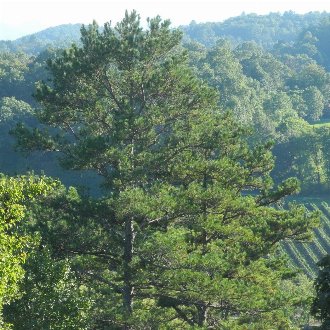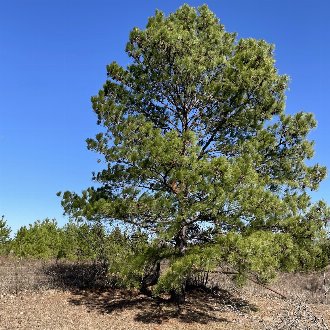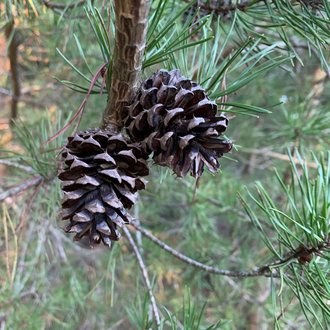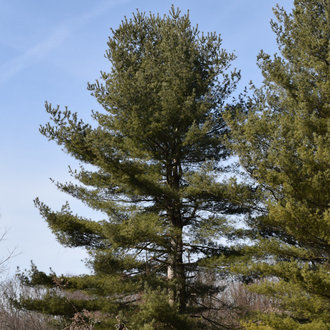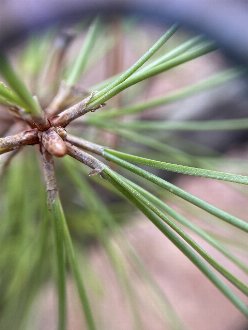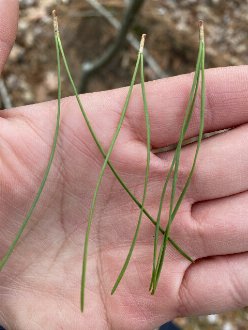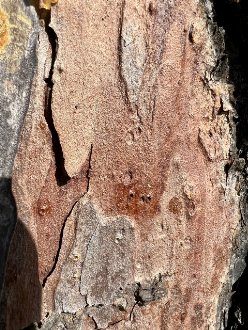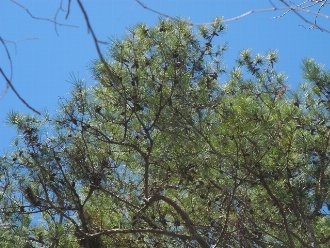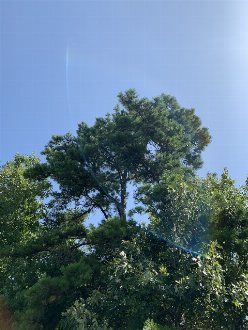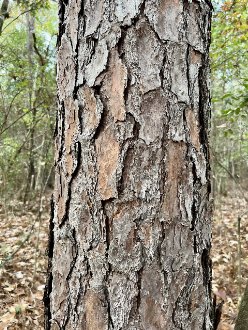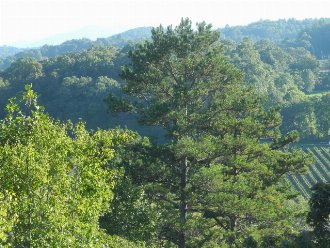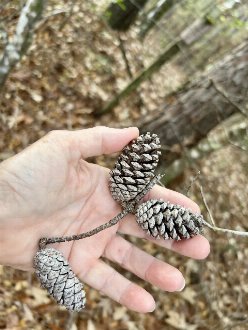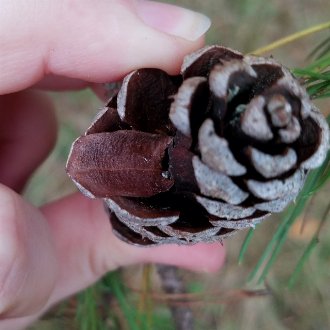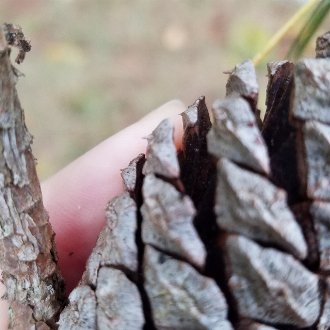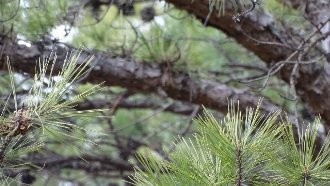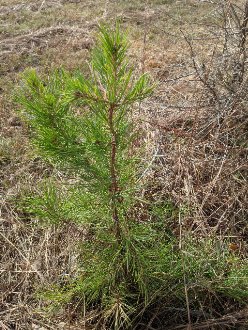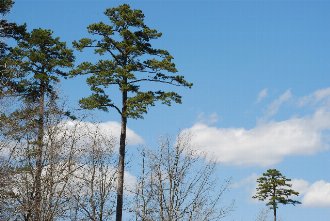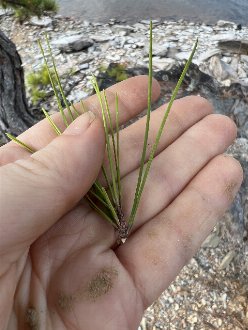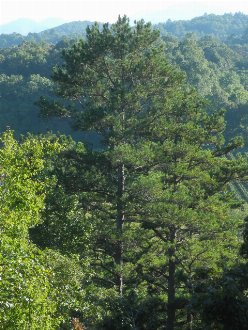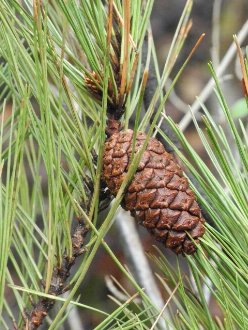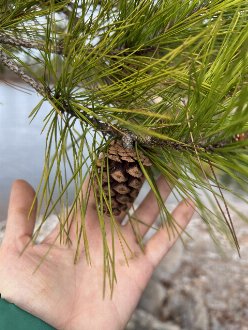Shortleaf Pine (Pinus echinata Mill.)
↑Summary
A native pine of the southeastern US, growing as a pioneer species, preferring leached soils, more common on dry uplands but found in many conditions.
↑Similar Plants
↑Habitat
Found mostly on mesic to dry uplands of the southeastern US, on sites with moderately well-drained soil low in both organic matter and mineral nutrients; also sometimes found on well-drained portions of floodplains. Frequently colonizes abandoned agricultural land.
Prefers deep, well-drained soils with a loamy texture, ranging from fine sandy loam to silty loam. Most commonly found on ultisols, specifically, udults, with the most favored soils being paleudults and hapludults. Mostly restricted to acidic soils with low calcium content. Requires good, but not excessive drainage; absent from poorly-aerated soils as well as coarse sands. Able to grow on rocky soils, but its growth is stunted.
Shortleaf pine is mostly found in early successional forests and as a relict species as forests mature. It is a pioneer species, often among the first to colonize a site, but due to its height it often persists longer, with a few pines surviving to 150-200 years, although it is not able to reproduce under a closed canopy of hardwood trees. It can persist long-term in habitats where fire or other disturbance maintains the more open conditions that allow it to reproduce. For this reason, it tends to be found in even-age stands, reflecting a large-scale disturbance that allowed it to colonize a site all at once.
Prefers habitats that experience low-to-moderate intensity ground fires, but absent from habitats experiencing regular severe fire. It is considerably less fire-tolerant than longleaf pine (Pinus palustris), but more fire-tolerant than loblolly pine (Pinus taeda).
Humans have greatly increased the habitat for this species by clearing old growth forests, and by regularly logging lands, allowing it to regenerate repeatedly and hindering the later-successional stages that exclude it. Unlike longleaf pine, it has not been as harmed by fire suppression, as human-induced disturbances are sufficient to allow its establishment. It also has benefitted from agriculture, as well as poor land use practices which have eroded richer topsoils, leaving more nutrient-poor mineral soils where it has a competitive advantage.
↑Life Cycle
Seeds germinate in early spring, with germination being best on exposed mineral soil. Seedlings quickly establish a taproot, soil conditions permitting. Occasionally the root development will proceed more laterally if the taproot is blocked by a hard layer. Growth of above-ground parts is minimal for the first two years, with seedlings investing most of their resources in root growth.
Unusual for a pine, the stem of seedlings usually falls over, remaining on the ground for 1-2 years. Stem growth is initially horizontal, but then curves upwards. This process forms a crook at ground level; buds form at the crook, which serve to initiate resprouting if the plant is top-killed. This process protects plants both from fire and herbivory. Seedlings facing too much competition from other plants may fail to develop this crook with protected buds and thus lose the ability to resprout.
Shortleaf pine tends to be slow growing and often does not fare well in the presence of competition from other trees, but it has lower nutrient requirements than most other large trees. As such, survival is best on sites where sterile soils hinder the growth of other plants. However, it can sometimes survive, albeit with its growth hindered, some amount of competition from taller trees. Under these circumstances, it responds well to release.
Trees begin producing seed at 20 years of age. Peak seed crops tend to occur at 3-10 year intervals in the north of its range, and 3-6 year intervals in the south. As trees mature and exceed about 6-8 inches DBH, they lose the ability to resprout.
For trees that survive to reach the canopy, the typical lifespan is 140 years, with some trees living to 200 years.
Trees can be killed by insect infestations following fire or mechanical damage, or by fungal infection facilitated by insect damage. Although trees are usually windfirm, trees on shallow root systems due to adverse soil conditions can sometimes be killed in severe windstorms. Ice storms are also a major source of damage to this species. Pole-size saplings are particularly susceptible to ice damage, often losing their main stems in severe storms. Mature trees may lose significant volumes of their canopy. Although trees can weather moderate drought better than most other species, severe drought can also kill trees.
↑Faunal Associations
Shortleaf pine has high importance to wildlife and ecosystems overall. It is a key structural component of the forests in which it occurs, as it is often the tallest tree and is evergreen, and thus serves to reduce wind speed and provide a degree of climate moderation and shelter year-round. This cover benefits both animals and other plants. However, there are also numerous animals that directly utilize this tree.
Seedlings are browsed by deer, but usually not killed by them. Dense stands of seedlings and saplings are important cover for the northern bobwhite (Colinus virginianus) and wild turkey. Older trees in decline, and dead trees, provide important nesting sites for cavity-nesting birds. Less commonly, red-cockaded woodpeckers will also create nests in healthy trees, but they prefer longleaf pine (Pinus palustris) because it is more likely to occur in habitats with open understories, which they favor. Canopies of mature trees are also important for pine warblers, which utilize them as nesting sites as well as during winter and migration. Shortleaf pine is particularly important to these birds, which are strictly dependent on pines, as there is a region of the central US, primarily Missouri and northern Arkansas and nearby, where this is the only native pine.
The seeds are eaten by various birds and small mammals and are an important food source for many of them.
Shortleaf pine supports numerous insects, most of which do not appreciably damage trees. The southern pine beetle (Dendroctonus frontalis) is one insect that can cause significant damage and mortality. Young trees can be damaged by the Nantucket pine tip moth (Rhyacionia frustrana), which feeds on tender new growth, including shoot tips, buds, and developing cones. The red-headed pine (sawfly Neodiprion lecontei) feed on the foliage of pines, preferring this species as well as other "yellow pines", and can defoliate whole trees under some circumstances. The Loblolly pine sawfly (Neodiprion taedae) also eats this species. The pales weevil (Hylobius pales) and pitch-eating weevil (Pachylobius picivorus) feed by chewing holes in bark, and can significantly damage young seedlings but usually pose no threat to adult trees.
Various pine engraver beetles (Ips sp.) feed mostly on the wood of decaying or damaged trees, especially those damaged by windthrow, occasionally attacking otherwise healthy trees during times of severe drought. These beetles can sometimes indirectly kill trees by leaving them vulnerable to fungal infection.
Most of these insects are more of a problem in monoculture plantations, where there is lower total biodiversity and fewer predators to keep infestations in check. Pesticide use in plantations can exacerbate this problem, protecting individual trees in the short-term but killing non-target insect species, both killing insect predators and decreasing other predator populations through eliminating their food supply, thus leading insect infestations to become more severe in the long-run.
Numerous other insects feed on this species without causing appreciable damage. The stripe-backed moth (Battaristis vittella) feeds on the buds and cones of this and other pines. The pine needleminer moth (Exoteleia pinifoliella) mine the needles of this and other pines. The eastern pine looper (Lambdina pellucidaria) feeds on the needles of this and other pines. Other lepidoptera recorded eating this species include the southern nepytia (Nepytia semiclusaria), which feeds on this and other pines, the tufted white pine caterpillar (Panthea furcilla), which feeds on various conifers, the confused zale moth (Zale confusa), the paler moodna moth (Moodna pallidostrinella), the pine-devil moth (Citheronia sepulcralis), the imperial moth (Eacles imperialis), the shortleaf pinecone borer moth (Eucosma cocana), which eats the cone of several pine species and prefers this one. The larvae of the eastern pine elfin (Callophrys niphon) eat this and other pines, among other foods including flowers and seedpods of various unrelated plants.
↑Uses
The wood of shortleaf pine is commercially important; when sold, it tends to be grouped together with other southern yellow pines, including longleaf pine (Pinus palustris), longleaf pine (Pinus palustris), and loblolly pine (Pinus taeda). Like these other species, the wood is valued for being hard, dense, and having good strength-to-weight ratios. The primary uses are in load-bearing construction, including bridges, beams, railroad ties, and poles. Lower-quality wood is used in plywood and for pulp. It tends to be widely available and moderately-priced.
This species is widely used in commercial forestry, where, besides the desireable properties of its lumber, it is valued for its tendency to regenerate in even-aged stands, and its ability to grow on relatively infertile sites that are not suitable for use as cropland.
It is sometimes used in landscaping. It has attractive foliage and form, is drought-tolerant and deer-resistant, and thrives on exposed sites with relatively infertile soil where other trees struggle. Its use in landscaping is limited by the fact that it is difficult to transplant, with transplanted trees often having a poorly-developed root system. The best way to grow this plant in landscaping is to prepare a seedbed of exposed mineral soil and then plant seeds or allow it to seed in on its own if there are already parent trees nearby, and then leave seedling in place when it comes up in a desireable spot.
Shortleaf pine can be used for reclamation of damaged or eroded land, but it is not always the best choice for this purpose. It produces less litter than loblolly pine (Pinus taeda), which thus makes a better choice on sites moist enough to support it. Shortleaf pine can be planted successfully on acidic mine spoils, but it is often less-suited to soil conditions on these sites than Virginia pine (Pinus virginiana), which often colonizes these sites on its own. However, when it survives, shortleaf pine can be longer-lived and is more fire-resistant. As shortleaf pine grows well with other pines, mixing species in a planting can maximize benefits while minimizing downsides.
↑Related Plants
This species belongs to Subsection Australes of the Pinus genus. Within this subsection it is thought to be closest-related to a subgrouping that includes longleaf pine (Pinus palustris) and slash pine (Pinus elliottii), both of which are native and overlap with it in range, as well as a few other species that do not occur in North America and do not overlap with its range, including P. cubensis, P. occidentalis, P. jaliscana, P. pringlei, and P. tecunmani.
↑Links & External Resources
• Shortleaf Pine | The Wood Database (About This Site)
• Shortleaf Pine | Fire Effects Information System (FEIS) (About This Site)
• Pinus echinata (Shortleaf Pine) | USDA PLANTS Database (About This Site)
• Shortleaf Pine | iNaturalist (About This Site)
• Pinus echinata (Short-Leaf Pine) | Missouri Botanical Garden Plant Finder (About This Site)
• Shortleaf Pine | Virginia Tech Dendrology Factsheets (About This Site)
• Shortleaf Pine | Silvics of North America (About This Site)
• Pinus echinata | Biota of North America Project (BONAP) (About This Site)
• Pinus echinata | NatureServe Explorer (About This Site)
• Pinus echinata | Flora of North America (About This Site)
• Pinus echinata Mill. | Plants of the World Online (POWO) (About This Site)
• Shortleaf Pine | Maryland Biodiversity Project (About This Site)
• Pinus echinata Miller (Shortleaf Pine) | Digital Atlas of the Virginia Flora (About This Site)



